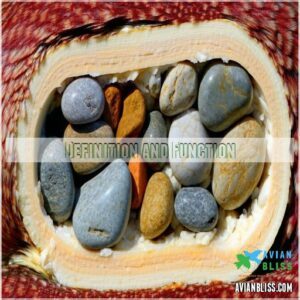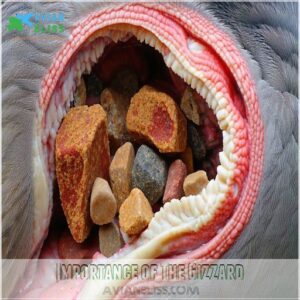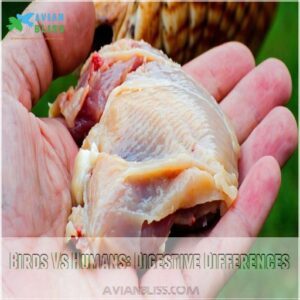This site is supported by our readers. We may earn a commission, at no cost to you, if you purchase through links.

You see, birds lack teeth, so they swallow these rocks to help with digestion.
These stones settle in the gizzard, a specialized stomach where food gets ground down.
It’s a bit like using a pestle to crush seeds and tough materials.
Some birds, like chickens, also gain essential minerals from these rocks, such as calcium and phosphorus.
So, stones aren’t just a culinary choice—they’re essential kitchen tools for birds!
This natural process keeps things running smoothly in their digestive tracts.
Curious about which birds enjoy these crunchy treats? Let’s explore further.
Table Of Contents
- Key Takeaways
- How Birds Digest Food
- Why Birds Eat Rocks
- What Are Gastroliths?
- The Gizzard and Gastrolith Relationship
- Birds That Consume Stones
- Stone Size and Type
- How Birds Swallow Stones
- Nutritional Benefits of Stone Consumption
- Other Benefits of Stone Consumption
- Birds Vs Humans: Digestive Differences
- Frequently Asked Questions (FAQs)
- Why do birds eat rocks?
- Why do birds eat stones?
- Why do birds eat gizzard stones?
- Why do birds eat grit rocks?
- Why do gizzards eat rocks?
- What do birds eat?
- How Do Baby Birds Get Their First Gizzard Stones?
- Can Birds Digest Their Food Properly Without Gizzard Stones?
- Do All Bird Species Use Gizzard Stones?
- How Do Birds Know Which Stones to Swallow?
- What Are Some Signs That a Bird May Have Problems With Its Gizzard Stones?
- Is there a bird that eats rocks?
- Why do birds peck at gravel?
- What is it called when birds eat gravel?
- Why do birds pick up stones?
- How do birds find suitable stones?
- Do all bird species eat rocks?
- Can birds overconsume stones?
- How long do stones stay inside birds?
- What happens if a bird cant find stones?
- Conclusion
Key Takeaways
- Birds swallow small stones, called gastroliths, to help them grind food in their gizzards since they don’t have teeth.
- These stones not only aid digestion but also provide essential minerals like calcium and phosphorus, which support overall bird health.
- From chickens to ducks, various bird species rely on stones to process tough food, demonstrating a unique adaptation in their digestive system.
- Without these stones, birds would struggle to digest hard seeds and grains, potentially leading to nutritional deficiencies.
How Birds Digest Food
Birds have a unique way of digesting food, relying on a gizzard filled with small rocks to break down tough materials.
By eating these stones, they create an internal grindstone that efficiently processes food they can’t chew.
Role of The Gizzard
Imagine you’re a bird without teeth — enter the gizzard, your personal food processor.
Deep within its muscular walls, the gizzard grinds up meals using grit and stones.
Here’s how it works:
- Muscle Power: The gizzard uses strong contractions to mash food.
- Efficient System: It pulverizes tough seeds and plant matter.
- Gizzard Health: Proper functioning promotes smooth digestion.
This marvel of evolution keeps you fueled and ready for flight!
Importance of Gastroliths
Gastroliths play a key role in bird digestion by compensating for the lack of teeth.
These tiny stones, ranging from sand grains to small pebbles, aid the gizzard in grinding down food efficiently.
Gastrolith Size Gizzard Health Grit Types
—
small
medium
large
variation
By facilitating efficient digestion, gastroliths help maintain a bird’s nutritional needs and overall health.
Why Birds Eat Rocks
Ever wondered why birds munch on rocks? It’s not just a quirky habit but a vital part of their digestion. Birds eat rocks, or "grit," for several reasons, and here’s the scoop:
- Gizzard Function: Birds lack teeth, so they rely on a muscular part of their stomach called the gizzard to grind food. Stones in the gizzard break down tough seeds and fibrous plant material, much like a natural blender. The gizzard’s powerful muscle contractions, enhanced by the gastroliths, break down tough items like seeds, as explained in the Gastroliths Role.
- Gastroliths and Health: These stones, known as gastroliths, help them grind food effectively, leading to better nutrient absorption, which is key to bird health.
- Behavioral Instincts: Consuming stones fulfills certain instinctual behaviors, ensuring their digestive system runs smoothly while satisfying their natural pecking habits.
By regularly ingesting these rocky bits, birds transform tough morsels into digestible food, maintaining their energetic lifestyles. So, the next time you see a bird snacking on stones, know it’s all in a day’s work for their digestion.
What Are Gastroliths?
You’ve probably wondered about those rocks birds swallow; they’re called gastroliths.
These stones, pebbles, or grit act as internal grinding tools within a bird’s gizzard.
They help them digest their food efficiently.
Definition and Function
Switching gears from why birds munch on rocks, let’s explore what gastroliths are.
Think of them as nature’s little grinders—tiny stones or grit birds swallow that hang out in the gizzard.
Birds can collect these stones naturally or obtain them through supplemental bird grit.
They play a key role by helping crush and mash food into digestible bits.
This gritty team helps birds efficiently extract nutrients, keeping their digestion processes humming smoothly.
Types of Gastroliths
Just as each bird is unique, gastroliths come in all shapes and sizes.
They range from tiny sand grains to larger pebbles.
Birds that forage on pine seeds, like the Pygmy Nuthatch’s pine seed diet, may also pick up small rocks as gastroliths.
The color and composition of these stones can vary, often depending on a bird’s environment or diet.
Whether it’s shiny quartz or rugged flint, every rock plays a part in the bird’s culinary toolkit.
How Gastroliths Work
When birds swallow stones, these become gastroliths residing in their gizzards.
Picture these stones as tiny, tireless grinders, crushing seeds and tough food into bite-sized particles.
As grit, they work seamlessly with the gizzard’s muscles, enhancing digestion.
Over time, stones wear smooth and need replacing, prompting another round of careful stone selection.
It’s nature’s clever, built-in food processor!
The Gizzard and Gastrolith Relationship
In the bird world, the gizzard teams up with gastroliths to act as a powerful grinder, breaking down tough foods efficiently.
These swallowed stones help the gizzard crush what’s on the menu, demonstrating a unique digestive strategy you won’t find just anywhere.
How They Work Together
Imagine a bird’s gizzard as nature’s blender, where gastroliths play the role of blades. Together, they transform tough foods into digestible bites. The gizzard contracts, rubbing food against the gastroliths to grind everything down. You’d be amazed at how:
- Gastroliths act as teeth
- Gizzard provides muscular power
- Stones come in various sizes
- Grit aids efficient digestion
The gizzard acts like a muscular stomach, using gastroliths to grind food. These gastroliths, or stones, are ingested by the bird and act as teeth. They come in various sizes and provide the grinding power, while the gizzard itself provides the muscular force. This process, aided by grit, ensures efficient digestion.
Importance of The Gizzard
The gizzard, nature’s answer to jaws, is key in bird digestion.
This muscular marvel operates like a tough food processor, using grit and stones to grind what birds can’t chew.
Without this internal mill, tough seeds and fibrous plant material would be impossible to digest.
Healthy gizzards mean efficient digestion, ensuring birds get needed nutrients swiftly.
Role of Gastroliths in The Gizzard
A bird’s gizzard is a powerful grinder, and gastroliths are its essential tools. Think of them as the bird’s natural teeth! These stones help break down tough food. In the gizzard’s acidic environment, the gastroliths work together with the gizzard’s muscular structure, allowing for efficient grinding and nutrient absorption.
- Gastrolith size matters; larger stones crush bigger bits.
- Grit selection is key; birds choose stones carefully.
- Gastrolith replacement is regular; worn stones are expelled.
- Gizzard function relies heavily on these swallowed stones.
Birds That Consume Stones
When you think of birds eating rocks, it might seem odd, but it’s really important for many species.
Birds like chickens, pigeons, and ducks swallow stones to break down seeds and other tough foods in their gizzards, ensuring they absorb nutrients effectively.
Types of Birds
You’re probably curious about why some birds munch on rocks.
Birds of prey, seed eaters, water birds, insectivores, and omnivores all use stones in their gizzards.
Here’s a quick peek:
| Bird Type | Diet |
|---|---|
| Birds of Prey | Meat |
| Seed Eaters | Grains |
| Water Birds | Aquatic plants |
Their gizzards and gastroliths turn grit into a secret digestion tool.
Characteristics of Birds That Eat Stones
When considering birds that eat stones, think about their specialized beak shapes, suited for their gritty diet.
These birds often have digestive system adaptations, like large gizzards, enabling them to grind food efficiently.
Their habitat preferences influence the availability of suitable rocks.
By their nature, these birds have evolved to thrive with this unique digestive mechanism, ensuring their nutritional needs are met.
Examples of Birds That Eat Stones
Stone-eating birds have fascinating diets, a necessity for their gizzards.
Here are a few feathered examples:
- Chickens and Turkeys: Common farm birds that pick up grit to help digest grains and seeds.
- Ducks and Geese: Rely on stones to tackle tough plant material in wetlands.
- Grouse and Quail: Forest dwellers often snatch pebbles for their fibrous meals.
Stone Size and Type
When birds eat stones, they don’t just grab anything—they’re particular about the size and type. Small pebbles might suit a sparrow, while larger ones fit a turkey’s needs.
Variety of Stones Consumed
Ever wondered about the variety of stones birds swallow?
Birds favor stones ranging from tiny sand grains to small pebbles.
These gizzard stones, or gastroliths, come from diverse sources like riverbeds, soil, or gravel paths.
In fact, the consumption of grit, like small stones or gravel, plays a key role in avian digestion processes.
The key here is finding the right grit composition and mineral content to aid digestion.
It’s a quirky yet essential part of their dietary routine!
Characteristics of Stones Consumed
So, you’ve seen the variety of stones birds gobble up. Now, let’s look at what makes these rocks special.
Stone shape varies—some are smooth, others rough.
Mineral content differs, influencing how well they grind.
Hardness matters too; softer stones wear down faster.
Color? That’s less important for digestion, though it can be interesting!
These characteristics determine how effectively a bird uses its gastroliths in its gizzard.
Importance of Stone Size
Birds are like picky diners when it comes to stone size.
Not just any rock will do—the type and shape of gizzard stones must match their diet and gizzard size.
Think of it as picking the right tool for the job.
- Large stones: Ideal for big-seed eaters.
- Tiny pebbles: Perfect for delicate plants.
- Rounded shapes: Suit small gizzards.
How Birds Swallow Stones
When you see birds pecking at the ground, they might be collecting stones to help with their digestion.
Birds swallow these stones with surprising ease, which then settle in their gizzard to grind up food efficiently.
Timing of Stone Ingestion
Understanding when birds eat stones can be a bit like waiting for the perfect moment to sip a hot cup of tea—timing matters!
Stone ingestion frequency often relies on diet and season.
Birds might swallow more gizzard stones when hard seeds dominate their menu.
Younger birds may adjust their stone size preference as their digestive needs evolve amidst changing seasons and dietary influences.
Techniques of Swallowing Stones
Have you ever wondered how birds handle swallowing stones?
It’s like their version of choosing a perfect avocado—not too hard, not too soft.
Birds pick stones, pebbles, and gastroliths based on size and their gizzard’s needs.
With practiced ease, they gulp these down, aiding their digestion.
This stone selection limits frequent consumption, ensuring the best possible gizzard performance.
Behavioral Patterns
Ever wondered how bird swallowing habits play out in the wild?
It’s a dance of grit preferences and gizzard function.
Birds, varying by species, pick stones based on size and texture.
They’ve got their unique swallowing techniques, sometimes almost comical!
Each pebble assists the gizzard in digesting the toughest seeds, highlighting fascinating bird behavior in action.
Nutritional Benefits of Stone Consumption
You might be surprised to learn that the stones birds eat aren’t just for grinding food; they also provide essential minerals like calcium and phosphorus.
These minerals are important for strong bones, healthy eggshells, and overall bird health, making stone consumption a key part of their diet.
Essential Minerals
Now, let’s chew on why birds swallow stones.
These pebbles aren’t just grit—they’re packed with essential minerals like calcium and phosphorus, superheroes for bone health and shell formation.
So, when birds munch on rocks, they’re not just grinding food; they’re dodging mineral deficiency.
Think of stones as nature’s multivitamins for birds, keeping their digestive system humming.
Support for Physiological Processes
Beyond supplying minerals for bone health, those little stones, or gastroliths, are like personal trainers for a bird’s digestive system.
They enhance digestive efficiency by grinding food in the gizzard, ensuring smoother nutrient absorption.
Imagine a natural blender working tirelessly to support overall well-being, from eggshell formation to mineral absorption, without needing an electrical outlet—all powered by humble stomach stones.
Importance of Stone Consumption
While stones don’t make for a gourmet buffet, they’re a key part of a bird’s diet, much like vitamins for you.
These pebbles and rocks in the gizzard crush food, enhancing nutrient absorption.
Besides aiding digestion, they’re small mineral deposits important for bone strength and egg formation.
It’s a quirky menu item, but essential for keeping birds chirpy!
Other Benefits of Stone Consumption
When birds eat stones, they’re not just helping their digestive system; they also support gut health and detoxification.
By consuming rocks, birds can maintain a balanced gut environment and satisfy natural behavioral needs.
Gut Health Regulation
Ever wonder how birds keep their gut health in check.
Those tiny stones they swallow play a hand in managing the bird digestive system, and for domestic birds like chickens, products like chicken grit supplements are often provided to aid in digestion.
By scuffing up the gizzard, stones help create a cozy home for beneficial bacteria and gut microbes, boosting digestive efficiency like probiotics do.
This also aids in enzyme production, keeping birds light on their feet.
Natural Detoxification
Birds munching on stones isn’t just about a healthy gut; it’s also a natural detox method.
These little rocks help remove environmental toxins trapped in their gizzards by binding to harmful particles.
Think of the stones as a cleanup crew in their digestive system, providing these surprising perks for bird health benefits.
- Gut allies: Keeping things tidy
- Environmental warriors: Busting toxins
- Health guards: Shielding from harm
Behavioral Satisfaction
Beyond detoxification, stone consumption sometimes satisfies a bird’s instinctive need.
Think of it like a parrot’s beak manipulation – a way to relieve stress.
Rock preference varies, but the act itself provides behavioral enrichment.
This isn’t just about digestion; it’s about a bird’s overall well-being.
Their gizzard needs those pebbles, but their minds might need the act of choosing and swallowing them, too.
For some species, it’s simply part of being a bird.
Birds Vs Humans: Digestive Differences
When you compare bird and human digestion, you’ll notice some fascinating differences, especially the role of gizzards in birds.
While you chew your food with teeth, birds use swallowed stones and muscular gizzards to break down tough meals.
Human Digestive System
In the human digestive system, food journeys through a well-organized process.
With the help of digestive enzymes, your stomach breaks down meals with precision, and for those looking to support this process, you can explore products for a healthy human digestive system.
Unlike birds with their stones and gizzards, humans rely on gut bacteria and enzymes for food breakdown.
This intricate dance guarantees nutrients are absorbed efficiently, keeping our bodies fueled and healthy without needing to swallow rocks!
Comparison of Gizzards
While humans rely on teeth, birds’ gizzards do the grinding magic, thanks to their muscular strength and evolution.
Consider these differences:
- Gizzard size: Birds boast a compact powerhouse unlike our sprawling system.
- Gizzard strength: Stronger than you might think, crushing gastroliths effortlessly.
- Gizzard function: It’s the natural blender for bird diets.
- Gizzard structure: Designed to withstand the toughest seeds.
Unique Aspects of Avian Digestion
Imagine the avian digestive system as nature’s efficient, muscle-bound processor.
Birds rely on the impressive strength of their gizzard muscles and unique digestive enzymes for processing food, which also protects them against viruses like avian influenza.
Coupled with gastroliths, these adaptations make their digestive process truly fascinating.
Let’s compare their digestion with ours:
| Aspects | Birds | Humans |
|---|---|---|
| Enzymes | Unique | Standard |
| Digestive Aid | Gastroliths | Teeth |
| Processing | Gizzard | Stomach |
| Bacteria | Avian-specific | Similar |
| Food Volume | High efficiency | Moderate |
Frequently Asked Questions (FAQs)
Why do birds eat rocks?
Birds swallow small stones, called gastroliths, to help them digest food.
Think of it as their own personal, built-in food processor!
These stones grind up tough seeds and nuts in their gizzard, a muscular pouch.
Why do birds eat stones?
You might wonder why birds eat stones, but it’s actually a clever survival tactic.
Gastroliths, or stones, help grind food in their gizzard.
This makes it easier to digest tough seeds, grains, and nuts.
Why do birds eat gizzard stones?
Nestled within the complex world of avian digestion, gizzard stones are essential.
They act like tiny millstones, grinding down food in birds’ gizzards to aid digestion.
Without these stone helpers, birds can’t effectively process tough seeds and grains.
Why do birds eat grit rocks?
Eating grit rocks helps birds digest food efficiently.
These stones sit in the gizzard, acting like a natural grinder.
By breaking down hard foods, grit enhances nutrient absorption and keeps your feathered friends healthy and well-nourished.
Why do gizzards eat rocks?
Gizzards eat rocks, which birds swallow, to function effectively like nature’s grinder.
These stones help break down tough food by grinding it in the gizzard, ensuring birds can digest nutrients properly.
It’s a fascinating natural digestive strategy.
What do birds eat?
Birds chow down on a variety of foods like seeds, fruits, insects, and nectar.
Some even enjoy fish or small mammals.
Diverse diets help birds get the nutrients they need to thrive in their environments.
How Do Baby Birds Get Their First Gizzard Stones?
Parent birds help their chicks! They’ll often bring small pebbles or grit alongside food. These tiny stones begin populating the chick’s gizzard, aiding digestion from day one.
Can Birds Digest Their Food Properly Without Gizzard Stones?
Like a car without fuel, birds can’t digest hard foods efficiently without gizzard stones.
These stones grind food into smaller bits for easy digestion, enhancing nutrient absorption.
Without them, birds face difficulties processing tough seeds and grains.
Do All Bird Species Use Gizzard Stones?
Not all bird species use gizzard stones.
Birds that consume seeds, grains, or hard-shelled prey need them to crush food effectively.
But birds with softer diets, like nectar-feeders, generally don’t require them.
How Do Birds Know Which Stones to Swallow?
Just as a chef selects the right knife, birds instinctively choose stones by size, texture, and mineral content, thanks to evolutionary cues.
Their sensory skills guide them to pebbles that optimize digestion in their gizzard.
What Are Some Signs That a Bird May Have Problems With Its Gizzard Stones?
If your bird’s eating fewer stones, struggling to digest, has weight loss, or shows behavior changes, its gizzard stones might be the culprit.
Watch for lethargy or digestive issues—signs of potential gizzard complications.
Is there a bird that eats rocks?
Yes, birds like chickens, turkeys, and pigeons eat rocks or grit to help their gizzard grind food.
This quirky habit acts like a natural blender, letting them digest tougher foods like seeds and grains effectively.
Why do birds peck at gravel?
Birds peck at gravel to help grind food in their gizzards, as it acts like natural sandpaper.
Gravel assists in breaking down tough seeds and materials, promoting effective digestion and nutrient absorption for healthy growth and energy.
What is it called when birds eat gravel?
You’ve likely seen birds pecking at gravel; it’s called gastrolith ingestion. They swallow small stones to help grind food in their gizzards, acting like tiny, natural teeth.
Why do birds pick up stones?
When birds pick up stones, they’re collecting essential tools to aid digestion.
These stones, or gastroliths, grind food into smaller particles in the gizzard.
This process makes nutrients more accessible for absorption.
How do birds find suitable stones?
To find suitable stones, birds often forage on the ground.
They select rocks that fit their gizzard size.
Birds even visit specific grit sources, like granite outcrops or riverbanks, to collect stones that aid digestion.
Do all bird species eat rocks?
Not all bird species eat rocks, but many do to aid digestion.
About 70% of birds use gastroliths, or small stones, to grind food in their gizzards, helping those who consume seeds, grains, and tough plant material.
Can birds overconsume stones?
Birds can ingest too many stones if their diet is imbalanced or in unusual conditions like captivity.
Overconsumption might lead to impaction or digestive issues, but generally, birds regulate their grit intake instinctively and effectively.
How long do stones stay inside birds?
It depends on the bird and the stone’s size.
Smaller stones pass through quicker; larger ones might stay for days or even weeks.
Think of it like their own little, natural digestive system rocks!
What happens if a bird cant find stones?
Imagine a dinner without utensils; that’s a bird without stones!
Without them, a bird’s digestion slows since the gizzard can’t grind food effectively.
Over time, this could lead to nutritional deficiencies and digestive issues, potentially impacting survival.
Conclusion
Just as humans use tools to make tasks easier, birds rely on rocks to aid digestion.
These stones, or gastroliths, act like teeth, grinding food in the bird’s gizzard.
They’re essential for nutrient absorption and overall health, providing minerals like calcium.
This remarkable adaptation shows why birds eat rocks—it’s a survival strategy deeply embedded in their biology.
By understanding this unique dietary habit, you get a glimpse into the fascinating world of avian life.

















